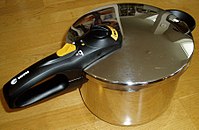
Photo from wikipedia
OBJECTIVE To compare the effects of dry needling or manual pressure release on an active trigger point in the upper trapezius on cranio-cervical flexion test performance, pressure pain thresholds, and… Click to show full abstract
OBJECTIVE To compare the effects of dry needling or manual pressure release on an active trigger point in the upper trapezius on cranio-cervical flexion test performance, pressure pain thresholds, and cervical range of motion in chronic neck pain. DESIGN A parallel randomized clinical trial. SETTING Physical therapy service. SUBJECTS Individuals with chronic neck pain. METHODS Subjects were randomized to receive dry needling (n = 25) or manual trigger point pressure release (n = 25) on upper trapezius active trigger points. Surface electromyography from upper trapezius, splenius capitis, sternocleidomastoid, and scalene muscles during performance of the cranio-cervical flexion test was assessed before and immediately after the intervention as primary outcome. Neck pain intensity, range of motion and pressure pain thresholds were the secondary outcomes. RESULTS A decrease in sternocleidomastoid activity on all stages of the cranio-cervical flexion test (time effect, p < 0.001) was found in both groups after the interventions, with no significant between-group difference. Pressure pain thresholds measured over the cervical spine and second metacarpal increased after dry needling when compared to manual trigger point pressure release (p < 0.05). Pain intensity decreased immediately after both treatments with moderate to large effect sizes, whereas cervical range of motion increased for both groups but with small effect sizes. CONCLUSION A single session of dry needling or manual pressure release over upper trapezius active trigger points promotes limited effects on muscle performance during the cranio-cervical flexion test, pressure pain thresholds and cervical range of motion in patients with chronic neck pain.
Journal Title: Pain medicine
Year Published: 2022
Link to full text (if available)
Share on Social Media: Sign Up to like & get
recommendations!